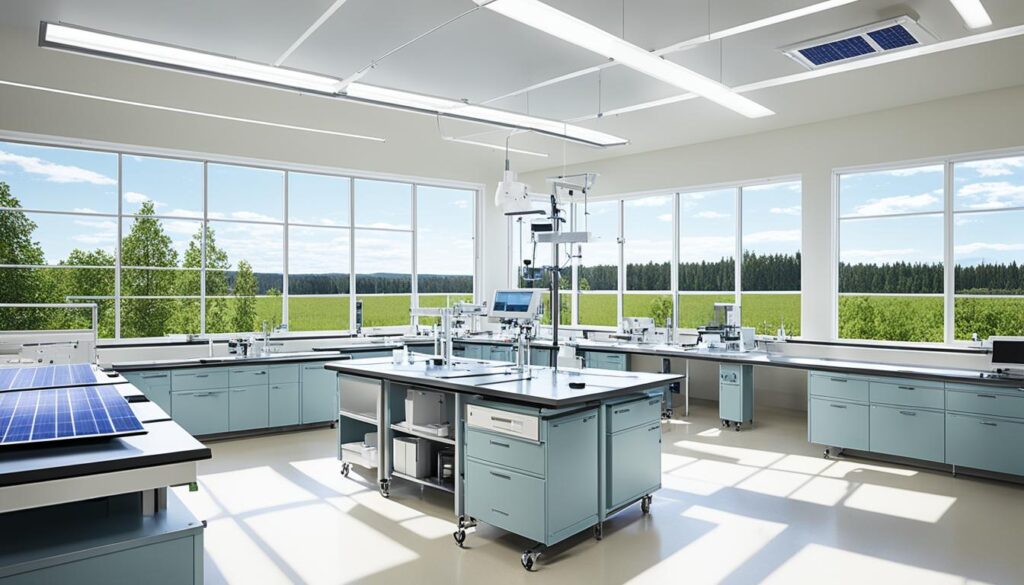
Providing top-notch care for patients must go hand in hand with our planet’s health. Hospitals are big contributors to global issues like emissions and climate change. The healthcare sector makes up 4.4% of the world’s emissions. That’s the same as the emissions from 514 coal-powered plants. In the US, hospitals alone produce 27% of the world’s healthcare greenhouse gas emissions.
Many hospitals are tackling this issue by embracing solar energy. Using the sun’s power lets hospitals shrink their carbon footprint. It also boosts care for patients and shows they care about the environment. Solar power isn’t just about going green or lowering costs. It shows a commitment to community health and well-being.
Key Takeaways:
- Solar energy can significantly reduce the carbon footprint of hospitals.
- By embracing renewable energy, hospitals can promote patient care.
- Solar energy projects demonstrate a commitment to environmental stewardship.
- The healthcare sector has a significant impact on global greenhouse gas emissions.
- Hospitals play a crucial role in protecting the health and well-being of communities.
The Benefits of Solar Energy for Hospitals
Transitioning to solar power is critical for hospitals. It helps them cut their carbon footprint and support the planet. Solar energy brings many pluses to healthcare, such as:
1. Reduced Carbon Footprint
Solar energy is a green way to power hospitals. It cuts down on harmful emissions. Energy use creates over half of a hospital’s carbon pollution. Relying more on the sun helps hospitals fight these impacts.
Hospitals can make their own electricity from sunlight. This means they use less fossil fuels. By doing this, they lower the harm to the earth.
2. Energy Efficiency
Solar systems are part of better energy use. Pairing them with LED lights and smart heating and cooling helps even more. These steps lower energy bills and help hospitals spend more on patient care.
3. LEED Certification
Some hospitals earn LEED certification. It shows they are eco-friendly and energy-aware. By aiming for LEED, hospitals want to make inside air better, save resources, and shrink their overall impact.
Using solar energy plays a big role in being LEED-certified. It points to a hospital’s strong effort in protecting the environment.
In short, solar power is a big win for hospitals. It helps them be kinder to the planet, spend wisely, and be healthier overall. Going for LEED shows a hospital’s deep care for both the environment and its patients.
| Benefits of Solar Energy for Hospitals | |
|---|---|
| Reduced Carbon Footprint | Transitioning to solar power significantly reduces greenhouse gas emissions in the healthcare industry. |
| Energy Efficiency | Implementing solar energy systems, along with efficient technologies, improves energy efficiency and reduces electricity consumption. |
| LEED Certification | Solar energy systems contribute to achieving LEED certification for environmentally friendly and energy-efficient hospital buildings. |

Promoting Sustainability in Healthcare Facilities
Hospitals and healthcare facilities are leading in green efforts. They aim to be eco-friendly and lower their impact on Earth. Here are some ways they are doing this:
Environmental Initiatives
- Universities, like the University of California system, push for clean energy goals. By 2025, they want to use only green electricity. This will help cut back on the carbon output from the healthcare field.
- The Cleveland Clinic aims to be carbon neutral by 2027. They are setting the bar high with their green practices.
Transportation Options
Healthcare sites are encouraging people to travel in ways that are kind to the planet. This includes their own workers and visitors:
- Biking spots and shared bikes are available to encourage green commuting.
- Places are working with public transport to offer better bus and train access.
- Plus, there are carpooling schemes to cut down on the number of cars used.
Energy-Saving Strategies
Hospitals are looking for ways to use less energy and cut costs:
- They use smart lighting and sensors to avoid wasting power on lights where not needed.
- Strategies are employed to even out energy use to avoid big surges in demand.
- Better heating and cooling systems are being installed to use energy more efficiently.
Sustainable Labs
Labs in healthcare are working to be more green, too:
- Harvard leads with a program to cut lab energy and promote friendly competitions.
- Simple changes, like adjusting freezer temps, are saving energy and money.
- They are also recycling chemicals, lessening waste and being more eco-conscious.
“The future of sustainable healthcare lies in our collective efforts to implement environmentally conscious practices. By promoting renewable energy, encouraging sustainable transportation, adopting energy-saving strategies, and making our labs more sustainable, we can create a healthier and more sustainable future for both patients and the planet.” – Anonymous
Together, healthcare places are showing the way in green living. These steps not only help their own carbon footprint but also set an example for other fields. It’s all part of a push for a greener, cleaner tomorrow.
| Environmental Initiatives | Transportation Options | Energy-Saving Strategies | Sustainable Labs |
|---|---|---|---|
| University of California system aims to be 100% reliant on clean electricity by 2025 | Biking facilities and bike-sharing programs | Implementing lighting controls and occupancy sensors | Harvard’s Green Labs Program promotes energy-efficient practices |
| Cleveland Clinic working towards becoming carbon neutral by 2027 | Collaboration with local transportation authorities | Using demand-reduction strategies | Freezer temperature optimization to reduce energy consumption |
| Carpooling programs | Investing in energy-efficient HVAC systems | Chemical reuse programs |

Conclusion
Environmental sustainability is key in hospitals. It helps keep both patients and communities healthy. Hospitals are working to lower their environmental impact. They do this by using solar energy, managing land well, and improving how they produce food.
Choosing clean energy and being efficient in how they use energy makes hospitals greener. This not only helps the planet but also ensures high-quality care for patients. It fits into their goal of making everyone healthier. For healthcare groups, being green is a chance to show the path to a better world.
These hospitals, by coming together, can do a lot to cut down on harmful emissions. They can also improve community health. Their joint effort and dedication to being eco-friendly will shape a brighter, healthier future. Let’s work together to keep making a positive difference. Let’s live out our values of taking good care of the environment in our work.






